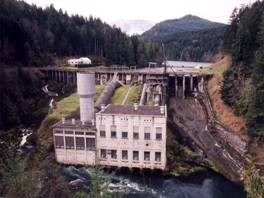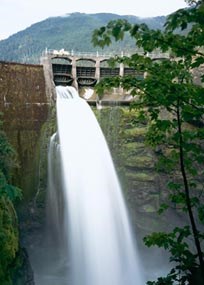
NPS Background: Hydroelectric projects in the U.S. are licensed through the Federal Energy Regulatory Commission (previously the Federal Power Commission) and governed by the Federal Power Act of 1920. The Elwha Dam, constructed from 1910 to 1913, preceded the act and has never been licensed to operate. The Glines Canyon hydroelectric project was constructed from 1925 to 1927 and received a 50-year operating license in 1926. 
Photo courtesy Scott Church 1940: Olympic National Park boundary is expanded to include the Glines Canyon hydroelectric site and lands previously held by the U.S. Forest Service. 1968: Crown Zellerbach files license application for the constructed Elwha Project. 1973: Crown Zellerbach Corporation files application for relicense of Glines Canyon. 1978: Federal Energy Regulatory Commission (FERC) issues notice of Glines Canyon relicense application. Various agency comments are filed throughout 1978. Washington State Department of Game is granted intervenor status. February 1986: Department of the Interior asserts that the FERC lacks jurisdiction to license Glines Canyon. May 1986: Seattle Audubon Society, Friends of the Earth, Olympic Park Associates, and Sierra Club, file motion for intervention and call for dam removal and full restoration of ecosystem. These groups, as well as the Lower Elwha Klallam Tribe and National November 1987: Crown Zellerbach files notice of change of its name to James River Corp. of Nevada. March 1988: Olympic Park Associates, Seattle Audubon Society, Friends of the Earth, and Sierra Club file petition for declaratory order finding that the Glines Canyon hydroelectric project cannot be relicensed by the FERC because it does not have jurisdiction. March 1989: National Marine Fisheries Service files study evaluating scope of dam removal/fish restoration on both projects. February 1990: General Accounting Office determines that FERC does not have authority to license the Glines Canyon Project, it being within the boundaries of Olympic National Park. July 1990: Department of the Interior files a Motion to File Late Intervention, Motion to Intervene, and Petition for Declaratory Order that FERC does not have authority to license the Glines Canyon Project. February 1991: FERC releases Draft Environmental Impact Statement concluding that (1) dam removal is feasible, (2) only dam removal will result in the full restoration of the Elwha River ecosystem and anadromous fish, and (3) the cost of power produced by the dam retention would equal or exceed the cost of power from the Bonneville Power Administration. March 1991: General Accounting Office concludes that "dam removal offers the best prospects for fish restoration: and decides that the selection of an alternative is essentially a public policy decision. April 1991: Pacific Fishery Management Council finds that only dam removal would provide restoration of anadromous fish at levels that would support increased recreational and commercial fishing, and requests that FERC consult with the Council. May 1991: Conservation Intervenors and tribe file Petitions for Review with Ninth Circuit for court review of FERC orders exerting licensing jurisdiction over Glines Canyon Project within Olympic National Park. June 1991: Department of Justice, on behalf of the Department of Commerce and Department of the Interior, files Petition for Judicial Review of FERC's October 19, 1990, and April 5, 1991 orders. June 1991: Ten additional conservation organizations file motion for intervention. October 1992: President George H.W. Bush signs the Elwha River Ecosystem and Fisheries Restoration Act as Public Law 102-495, staying the FERC licensing process. The Elwha Act calls for "full restoration of the Elwha River ecosystem and native anadromous fisheries." |
Last updated: February 28, 2015
